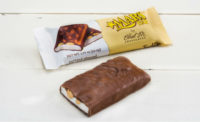Meet Nate Hodge, a political speech major and one-time songwriter and vocalist for the alternative folk/rock band, Tall Stranger. These days, however, he’s writing lyrics for a different life chapter, one that involves overseeing development and production of “virgin” chocolate products at Raaka Chocolate in Brooklyn, N.Y.
This somewhat atypical resume for a head chocolate maker actually represents the norm for many employees at Raaka, even more so for its founder Ryan Cheney. It was Cheney — his degree is in computer animation — who discovered the power of raw cocoa beans and minimally processed chocolate.
While attending yoga school in Koh Phangan, Thailand several years ago, Cheney had a chance to visit a cocoa farm and see the process of transforming cocoa beans into chocolate firsthand. Fascinated by the flavors inherent in cocoa beans as well as those attained in chocolate making, Cheney began to experiment, combining aphrodisiac herbs with raw chocolate.
Following a year of immersion in the art of bean-to-bar chocolate making, Cheney returned to New York City anxious to transform his learnings into a life’s work. There, he connected with Hodge, who quickly committed to the challenge of further developing the idea of bean-to-bar chocolate making.
Together, they two spent months refining their minimally processed chocolate in Hodge’s bedroom, converting that space into a micro bean-to-bar production point. Successful trials amongst friends and acquaintances as well as at farmers’ markets convinced the two to open up a facility in Clinton Hill, Brooklyn.
As Hodge, who’s worked in brewing, restaurants, tea and chocolate companies, explains, “I’ve tasted a lot of different chocolate bars, all of which have interesting and diverse flavors depending upon where the beans are from, be it Dominican Republic, Ecuador, Madagascar or elsewhere.”
By not roasting, Cheney and Hodge ascertain that more of the cocoa bean’s polyphenols and flavor notes are retained. By eschewing flavor development through traditional roasting, Raaka focuses on conching to attain deeper and more pronounced flavors and nuances. It is a longer, more involved process, but one that’s led to success and growth.
Just this September, Raaka moved its operation from Clinton Hill to the borough’s trendy Red Hook neighborhood. The new location quadruples the size of its previous production space from 1,000 to 4,000 sq. ft., as well as establishes the company’s first retail shop.
It also enables the company to double its output while providing customers an opportunity to see the bean-to-bar chocolate making process up close and personal. In addition, Raaka will also offer new programs for groups interested in learning more about bean-to-bar chocolate production with chocolate making classes, tasting tours and school trips.
Naturally, as with all chocolate operations, the process at Raaka begins with the beans. Beans come only from directly traded, ethically sourced suppliers of certified organic beans. And all shipments are closely inspected to ensure that only the best beans are used.
Currently, Raaka sources its cocoa beans from the Dominican Republic, Bolivia and Belize. Because the beans are not roasted, winnowing or cracking the beans requires a bit more muscle than a typical winnowing process. Raaka uses a cocoa bean cracking machine that segregates the nibs from the shells. All husks are donated to the Edible SchoolYard NYC, where the husks are used as mulch for vegetable gardens.
Once the shells are separated from the nibs, they are inspected and then fed into a grinder. At this point the cocoa liquor is transferred into any one of four Cocoatown melangers. And it is here that the flavor development occurs.
After a preliminary grind, the cocoa mass is fed into a three-roll refiner to better control the particle size. As Hodge notes, “There’s no way to ensure that all the cocoa is ground into the same particle size in the melanger.”
Once the mass undergoes refining, it’s back to the melanger for conching overnight, about 10-12 hours. It’s also at this stage that any additional ingredients, such as turbinado sugar and/or coconut milk are added. All Raaka products are vegan, so no milk is used. Once conching is completed, the chocolate gets tempered and is then poured into moulds. Any inclusions, such as nibs, seeds or dried fruits, are also added.
When asked about food safety issues, since the cocoa beans are not roasted, Hodge pointed out that the long-term conching process generates temperatures ranging between 145° to 150° C.
“That’s more than enough heat to kill any harmful microbes,” he says. “And consider those who do a light roast, where temperatures are in low 200s. That temperature doesn’t necessarily translate into an internal temperature within the nib.
“Moreover, when you look at the research of tainted chocolate, you find that most of the contamination comes from either spoiled milk and/or lead machine parts,” Hodge says.
But back to the production process. Once the bars cool overnight, they are then demoulded by hand and stacked for packaging. Initially, the bars were hand packed, but growth has enabled the company to purchase a wrapping machine. The addition has proven to be a key investment in allowing the company to double production, although the use of 100 percent post-consumer recycled paper with soy inks does preclude running the wrapper at full speed.
Nonetheless, there’s been no slow down in creativity regarding chocolate bar varieties, which has led to a 2013 Good Food Award for the company’s Bourbon Cask Aged 82% bar. It uses nibs that are aged for 30 days in bourbon casks, thus picking up caramel and earthy flavors. Other chocolate bar varieties include Dark with Himalayan Pink Sea Salt, Coconut Milk, Vanilla Rooibos and Yacón, which uses yacon, a Peruvian tuber for sweetness.
To kick off its expansion and relocation to Red Hook, the company also released two new chocolate bars for retail: Maple & Nibs and Lapsang Chai.
As Hodge points out, the company loves experimenting with flavors. This past summer, Raaka rolled out the following: Raspberry Lemonade, Dos Dominicanos 64% with 100% cocoa paste, 70% Papa New Guinea with Sweet Corn, and Mangosteen & Pomegrante Seeds in a Central American Cacao Blend.
Given its penchant for “shotgun innovation” as Hodges describes it, Raaka also offers a First Nibs monthly chocolate subscription. Consumers who sign on get three chocolate bars each month for $24. In October, subscribers received the following: A Ghost Pepper bar featuring 69% OKO Caribe from the Dominican Republic, a Coffee (Coconut) Milk bar that has 58% Maya Mountain Cacao from Belize and Lapsang Chai, which uses 66% CIABB Co-Op beans from Bolivia.
“The subscription offer is doing well; we already have 100 subscribers,” he says.
Web sales are also growing for the company. Although they represent just under 11 percent of all revenues, it is the fastest growing segment for Raaka.
Given its vegan, organic certification as well as the fact that the candy is nut- and gluten-free, Raaka’s line of bars fit perfectly for retailers such as Whole Foods. Currently, the company’s products are sold in Whole Food stores “from San Jose to Vancouver, from Philadelphia to Massachusetts,” says Hodge.
Then there’s the company’s social commitment to farmers, which focuses on working with co-operatives and farming communities to not only obtain the highest quality cocoa beans but to ensure premium pricing and equitable relationships.
In 2013, the company began sourcing cacao beans from Maya Mountain Cacao (MMC), a partnership impact enterprise based in Belize, which aims to improve the well-being of regional cacao farmers and provide them with the resources to create and maintain sustainable agroforestry.
Founded in 2010, MMC now sources from 275 certified organic farmers, who manage more than 600 acres of organic, shade grown cacao. Each farmer is each paid above the Fair Trade price floor for their beans. Moreover, MMC beans deliver an exquisite fruity, tropical flavor, says Hodge.
“Maya Mountain Cacao does a great job of adjusting their fermentation levels to get optimal flavor,” he explains. “They’re really on the cutting edge.”
Hodge expects Raaka to also remain on the cutting edge.
He’s working on introducing bon bons for the holidays which will include the use of such ingredients as olive oil, pumpkin seed oil, chiles, and even cacao fruit liqueur.
The aim, which goes back to Cheney’s days in Thailand, is for consumers to experience the “real power of the raw cocoa bean,” Hodge says. It’s the sensory experience, he adds. Obviously, more and more chocolate lovers seem to agree.
Related:
Recchuiti Confections
Dandelion Chocolate



















